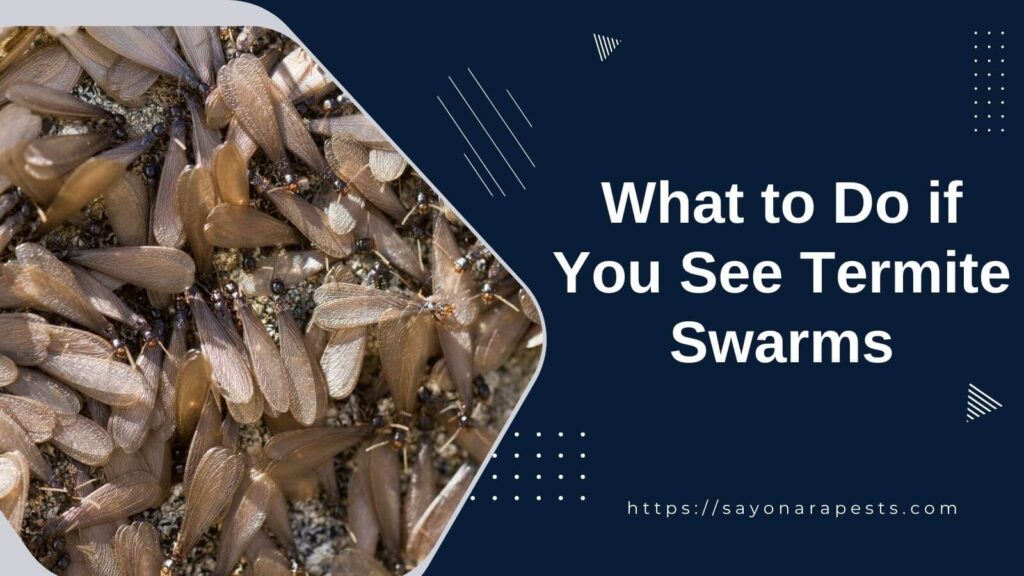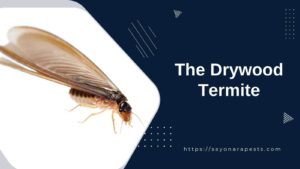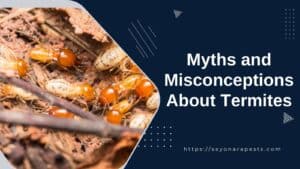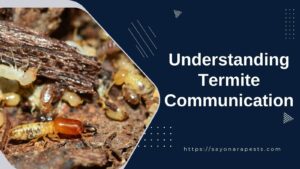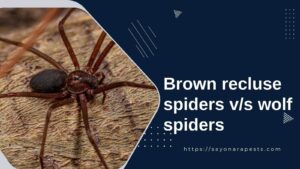Termite swarms are captivating and mysterious events that show how nature works in a way that is hard to understand. These temporary groups of winged termites, called alates, appear with great splendor and mark an important part of a termite’s life cycle
The colonies of termites, which are social insects in the order Isoptera, have a level of organization and division of labor that is unmatched. As they get older, some termites grow wings, which is a sign that the swarming phase has begun.
In the wide world of natural events, being able to recognize termite swarms is of the utmost importance. These gatherings are a key sign that termites are around, warning of possible dangers to human homes and wooden buildings.
When homeowners, pest control professionals, and researchers can identify termite swarms, they can figure out if they need to take preventative steps to protect against the destructive power of these tiny but relentless insects.
By noticing termite swarms quickly, people can take the right steps to protect their homes from the damage that termites can do.
When termite swarms are ignored, bad things can happen, making it clear that you need to act quickly and decisively. Termites can get into buildings and quietly eat wood from the inside because they can’t get enough cellulose-rich materials.
Termite infestations can cause homes, offices, and other buildings to become unstable if nothing is done to stop them. Damage from termites can cost a lot of money because it often needs expensive repairs and rebuilding.
Also, termite colonies can last for a long time, which means they can keep doing bad things and cause more damage to properties that are already at risk.
By acting quickly against termite swarms, people can reduce the risks posed by these dangerous bugs, protecting their investments and ensuring the long-term stability of their structures.
Termite swarms are fascinating to look at, but they also have big effects that go beyond their short-lived presence. Being able to recognize termite swarms is a key part of keeping our living spaces safe because it lets us take action against these hard creatures’ relentless attacks.
By realizing how important it is to act quickly against termite swarms, we strengthen our defenses and protect our buildings from the sneaky damage that termites can do. Let’s use the information and tools we have to fight these insects head-on and make a path toward a future without termites.
Understanding Termite Swarms
Termite swarms are mysterious natural events that fascinate and confuse both scientists and onlookers. They refer to the amazing ways that these tiny but powerful insects behave as a group.
Swarms happen when a large number of adult termites with wings come out of their underground nests at the same time. This is an amazing sight that looks like a symphony of nature.
These short-lived gatherings show how well termites can reproduce and are an important part of their life cycle.
Reasons for Termite Swarms
What drives termites to go on these unusual swarming trips is a mystery that has stumped entomologists and researchers for years. Even though scientists are still trying to figure out what causes it, there are a number of theories that can help explain it.
One popular theory says that termite swarms are mostly caused by things in the environment, like temperature, humidity, and the length of the day.
These things, which are like the conductor of nature’s symphony, make it so that termites come out of their hidden colonies at the same time.
Also, it is thought that chemical signals sent out by certain termites in their colonies serve as powerful ways for them to talk to each other. This starts a chain reaction that leads to spectacular swarming.
The complex dance of nature’s forces behind termite swarms is made clear by the way internal physiological changes and external stimuli work together.
When Termite Swarms Typically Occur
Termite swarms are mysterious and exciting because they happen at different times of the year in different places. But they tend to happen at certain times of the year when conditions are good for the winged reproductive termites to live and move around.
In temperate areas, swarms tend to happen in the spring, when the environment wakes up again after the cold winter. Termites are coming out in large numbers because the weather is getting warmer and there is more moisture in the soil.
In tropical and subtropical areas, termite swarms can happen at any time of the year. However, they are most active during the rainy seasons, when there is a lot of moisture, which helps the termites live and grow.
The exact timing and length of swarms in these areas can be affected by many things, such as the local climate, the availability of resources, and the unique traits of each termite species.
Scientists are still trying to figure out the mysteries behind termite swarms, which are fascinating displays of nature’s complexity.
As our knowledge grows, we learn more about the amazing adaptations and behaviors that have helped termites thrive and change ecosystems over time. This shows us how complicated and amazing the world is beneath the surface.
Identifying Termite Swarms
Termite swarms can be hard to spot for both homeowners and professionals in the pest control business. But if you pay close attention to certain signs, you can figure out what these creatures are hiding.
The wings that termites drop off are one of the most obvious signs of a swarm. As termites start to have babies, they lose their wings and leave a trail of clear pieces behind them.
These delicate wings, which are strewn across windowsills, doorways, and other entryways, are a mysterious clue that makes people both curious and worried.
Under the surface, underneath all the homes and buildings, there is another mystery: a network of mysterious mud tubes. Termites build these strange structures as a way to get around without being seen.
These mud tubes, which often look like winding tunnels, are evidence of how hard these tiny insects work to start new colonies and grow their territory.
When people see these complicated tunnels, it can make them feel scared and make them want to learn more about how to identify a termite swarm.
Differences between Termite Swarms and Ant Swarms
In the maze-like world of swarming insects, it can be hard to tell the difference between termite swarms and ant swarms. The confusing part is that there are only small differences between these two types of swarms, so you have to pay close attention and be able to tell them apart.
The untrained eye might not be able to tell these swarms apart, but a closer look shows that they are different.
The shape of their wings is one of the main ways in which termite swarms and ant swarms are different. Termite swarms have long, thin wings that are all the same size. They look like delicately veined lace.
In contrast, ant swarms have wings that are not the same size all the way around. The front wings are bigger than the back wings. This tiny detail, which is easy to miss in the chaos of swarming insects, is a key clue for those who want to figure out the mystery.
Also, the way these swarming insects act gives us important clues about how to tell them apart. When compared to ant swarms, termite swarms tend to be quieter and less busy.
Unlike termite swarms, which are more quiet and secretive, ant swarms have a noticeable burst of activity. This is because the wings of the ants in the swarm buzz in a rhythmic way, and the ants move quickly.
Seeing these small differences and figuring out what they mean can be hard. It takes a deep understanding of the complex behaviors and traits of these swarming creatures.
Figuring out what’s going on with swarms of termites requires a sharp eye and a willingness to step into the realm of mystery.
By figuring out what the signs of termite swarms, like discarded wings and complicated mud tubes, mean, homeowners can learn about what’s going on in the hidden parts of their homes.
Also, by being able to tell the difference between termite swarms and ant swarms, people can make their way through the complicated world of swarming insects and protect their homes from these silent invaders.
Why Termite Swarms Are Dangerous
Structural Damage
When it comes to the dangers that termite swarms can cause, you can’t ignore the fact that they pose a big risk to the stability of buildings. These tiny, but very hungry, insects can’t get enough of wood and other cellulose-based materials.
This makes them especially good at destroying the very foundations of our homes and businesses. Termite swarms can quickly invade and take over even the strongest buildings because they are so determined and there are so many of them.
As they do this, they slowly eat away at the important parts that keep the building together.
Termite swarms often cause damage to structures that are hard to spot and go unnoticed for a long time, which could lead to disastrous results. As these silent invaders eat away at the wooden beams, joists, and frames, they weaken the building’s ability to hold weight.
Over time, this can cause floors to sag, walls to crack, and in the worst cases, the whole structure can fall down. Termite infestations are hard for homeowners to notice until they’ve done a lot of damage.
This makes fixing the problem more expensive and difficult because the problem is hidden.
Health Risks
Even though termite swarms can do a lot of damage, their effects on human health are often overlooked. Even though these tiny bugs don’t hurt people directly, they do make the environment where people live less healthy.
As they eat through wood and make tunnels inside the building, they leave behind debris and feces that can cause allergic reactions and breathing problems in people who are sensitive to them.
Also, the presence of termites often means that there is too much moisture or dampness, which can cause mold and mildew to grow.
Fungal infections can make breathing problems worse and increase health risks, especially for people who already have breathing problems like asthma or allergies.
Mold can release spores into the air that can cause coughing, wheezing, and throat irritation, which can make people feel even worse about their health.
Financial Costs
Termite swarms not only threaten the physical health of buildings and the health of their people, but they also cost property owners a lot of money.
These sneaky bugs can do a lot of damage, which can cost a lot to fix. When an infestation goes unnoticed for a long time, the damage gets worse and costs go up significantly.
Getting rid of termites usually requires a full-scale plan that includes a professional inspection, extermination, and repair.
When you add up the cost of hiring professional pest control services and fixing up the damaged areas, it can quickly add up to a lot of money.
In some cases, a lot of damage may require a lot of repairs or even rebuilding of parts of the building. This can put a huge financial strain on the property owners.
Also, the financial effects of termite damage go beyond the costs of fixing it right away. Damage caused by termites is often only partially covered by insurance, leaving property owners to pay most of the cost.
A termite infestation can also lower the value of a property, making it harder to sell or rent out. This makes it even harder for the owner to make money.
In the end, termite swarms pose a number of risks, including damage to the building, health risks, and big financial costs.
Understanding the possible effects of a termite infestation is important for both homeowners and business owners, as early detection and quick action are the best ways to limit the damage.
By spending money on preventative measures, regular inspections, and quick fixes, people can protect their homes, keep their health safe, and avoid the huge costs that come with termite swarms.
How to Prevent Termite Swarms
Regular Termite Inspections
Termite swarms are a sneaky threat that can only be stopped by taking precautions. Having your home checked for termites regularly is one of the best ways to keep it safe.
These careful checks are a good way to stop these creatures that eat a lot of wood from moving forward all the time.
By hiring experienced pest control professionals, homeowners can use their knowledge and constant vigilance to stay one step ahead of these sneaky invaders.
During a thorough termite inspection, trained professionals look for termites in every corner and crevice of a building.
These careful inspectors look at every part of the building for signs of termite activity. They do this with sharp eyes and high-tech tools.
Even the smallest clues are picked up and looked at to find these hidden marauders, such as wood that sounds hollow or the presence of frass, which is a strange termite waste.
Homeowners can stop termite infestations before they do too much damage by giving their homes thorough inspections on a regular basis.
These preventive steps not only give homeowners an important early warning system, but they also give them the chance to take quick and targeted steps to get rid of termites, stopping the swarms from growing and protecting the structural integrity of their homes.
Proper Home Maintenance:
Proper home maintenance is an important part of the fight against termite swarms that should never be ignored.
Keeping your house clean and in good shape is a powerful way to keep these pests away, as it makes them less appealing to them.
Homeowners who are careful know how important it is to take this preventative step, which is a key line of defense against these wood-eating pests.
Upkeep is very important, both inside and outside. The most important thing to do is check for and fix any cracks or crevices in the foundation, walls, or roofing. Termites can get in through these weak spots.
Also, making sure the house has enough ventilation keeps moisture from building up, which makes the environment less good for termites to live in.
Protecting the wooden parts of a house is an important part of keeping it in good shape. Termites can’t get into wood that has been treated and protected in a timely manner, like by using the right sealants and coatings.
In the same way, checking wooden furniture, fixtures, and outdoor structures like decks and fences on a regular basis gives you a chance to spot any signs of termite activity quickly.
By being proactive about home maintenance, homeowners can reduce the chance of termite swarms and make it hard for these destructive creatures to live in their homes.
This all-around plan not only keeps the house looking nice and makes it last longer, but it also protects it from the relentless attack of termites and makes the home more sacred.
Addressing Moisture Problems:
When it comes to keeping termites away, dealing with moisture problems is a very important step that needs to be done carefully.
Moisture attracts termites like a magnet, drawing them into a home where they can find food and shelter.
By addressing problems with moisture head-on, homeowners can make their homes less appealing to these persistent invaders.
The first step in fixing moisture problems is to find any water leaks or plumbing problems and fix them.
Pipes that leak, faucets that drip, or drainage systems that don’t work right all create a lot of moisture, which termites find irresistible.
When you fix these leaks right away and make sure water flows and drains properly, you get rid of the source of moisture and make it hard for termites to live there.
Keeping the right amount of humidity in the house is also very important for keeping termites away. Using dehumidifiers in damp places like basements or crawl spaces cuts down on excess moisture and lowers the chance that termites will move in.
Also, making sure these areas have enough ventilation keeps the air moving, which keeps moisture from building up even more.
In outdoor areas, proper grading and the installation of gutters and downspouts are important ways to keep water from getting into the foundation.
By keeping the area around the house dry and well-drained, homeowners create an environment that termites don’t like. This makes it less likely that termite swarms will get inside the home.
Homeowners strengthen their defenses against termite swarms by taking care of moisture problems with determination.
This careful method breaks up the mutually beneficial relationship between water and termite survival. This destroys the basis on which these persistent pests thrive.
Homeowners take control of their environments by being alert and taking preventative steps. This keeps the threat of termite infestation at bay and protects the sanctity of their homes.
What to Do if You See Termite Swarms
Don’t Panic
When you see a swarm of termites, it can be scary, but it’s important not to freak out. When dealing with these kinds of situations, it’s important to stay calm and collected.
Panicking can make it hard to think clearly and make good decisions. Take a deep breath, gather your thoughts, and move on with a clear head. Remember that termite swarms can be scary, but they can be handled well if you take the right steps.
Call a Professional Termite Control Company
When you see swarms of termites, you need to call a professional termite control company right away.
These experts have the right knowledge, skills, and tools to accurately judge how bad the infestation is and figure out what to do about it.
If you don’t get help from a professional, you might not be able to fix the problem or you might even make it worse.
By hiring a reputable company to get rid of termites, you can take advantage of their knowledge and make sure the problem is fixed completely.
Temporary Measures to Reduce Damage
Termite swarms can do a lot of damage to your home, but there are a few things you can do while you wait for the pest control company to come.
First, make sure that all of your windows and doors are tightly sealed so that termites can’t get in. Also, get rid of any standing water because termites are drawn to damp places. Check for leaks and plumbing problems and fix them right away.
Also, don’t keep firewood or other pieces of wood near your house because it could be food for termites.
Even though these short-term steps can’t replace professional help, they can help reduce the immediate risk until long-term solutions are put in place.
Long-Term Solutions
Once the professional pest control company has figured out what’s going on, they will give you long-term solutions that are made to fit your needs.
Depending on how bad the infestation is, these solutions may include localized treatments or treatments of the whole building.
Localized treatments focus on specific areas where termites are active, while whole-structure treatments cover the whole building to make sure they are all gone.
Also, companies that get rid of termites may suggest preventive steps like putting up termite barriers or doing regular inspections to lower the risk of future infestations.
Remember that the best results from long-term solutions come from being patient and working together.
Follow the advice of experts and do the maintenance they tell you to do to protect your property from termites in the future.
In the end, seeing swarms of termites can be scary, but it’s important not to freak out. Instead, you should call a professional termite control company to come look at the problem and take care of it.
In the meantime, you can take temporary steps to lessen the damage that could happen, like sealing windows and doors, getting rid of sources of moisture, and removing wood debris.
Once the experts get there, they will give you long-term solutions that are tailored to your situation. These solutions may include treatments and preventive steps.
If you follow their advice and keep up with regular maintenance, you can protect your property from termite problems in the future. Remember that you can deal with termite swarms and protect your home if you stay calm and work with the right experts.
Termite Swarm Season and Geography
Seasonal Variations
Termite swarm season is a fascinating natural event that is caused by the way environmental cues and the complex biology of these amazing insects work together.
During this time, termites, those silent destroyers, come out of their underground homes and take to the skies in huge numbers, looking for new places to take over.
Changes in the seasons play a big role in figuring out when this amazing show happens.
In temperate areas, termite swarms usually happen in the warm, humid spring months, when the earth wakes up from its winter sleep and starts to grow again.
When these primitive creatures feel small changes in temperature and humidity, they get ready for the big event that is about to happen.
Their intricately coordinated behavior is a great example of how amazing evolution is. It helps them increase their chances of survival and keep their species going.
But in tropical areas where the sun’s warmth stays the same all year, termite swarm season can be harder to predict. Here, the main thing that brings these important groups together is the way the rain comes and goes.
As soon as it starts to rain, which brings life-giving water to the soil, termites take off on their long journey through the air.
The exact timing of these swarms is often a mystery, but it is controlled by a complex web of ecological cues. This helps these hardy creatures survive even when weather patterns are unpredictable.
Geographic Variations
The fascinating world of termite swarms isn’t limited by geography. Instead, it spreads out like a beautiful tapestry around the world, with each region adding its own unique details to this fascinating phenomenon.
From the vast savannas of Africa to the dense rainforests of South America, and from the dry deserts of Australia to the wide open spaces of North America, termite swarms have caught the attention and curiosity of scientists and fans alike.
Termite swarms are often tied to the rhythms of the savanna ecosystem in Africa, which is where people first lived.
These hardy insects are the backbone of a delicately balanced ecosystem. They feed a wide range of animals, both big and small.
Here, the rainy season and termite swarm season happen at the same time. When it rains, the dry ground gets watered again, and the stage is set for the amazing appearance of these winged builders.
In the lush rainforests of South America, termite swarms dance in the air to the rhythm of the tropical life around them. There are so many different kinds of termites in this area that it’s hard to keep track of them all. Each species has its own way of acting and role in the environment.
Some termites start their journey at night, while others take off in the middle of the day, making the sky look like a kaleidoscope of flapping wings.
Their complicated relationships with the dense plants and other animals in the forest make up a web of connections that shapes the way these green ecosystems work.
Even in the barren areas of the Australian outback, where life is close to being too hard, termite swarms show how tough they are.
These smart insects have changed so that they can live in a place where water is scarce and temperatures can get very high.
They carefully time when they come out to coincide with the brief periods of moisture. They use this time to reproduce and settle new areas before going back into their underground kingdoms.
Termite swarm season is different in different parts of North America because of the different landscapes. From the wide-open fields of the Midwest to the tall forests of the Pacific Northwest, termites take advantage of the chance to move into new areas.
Because of differences in climate, soil, and ecosystems, there are many different kinds of termites. Each has its own preferred habitat and way of swarming.
These swarms, which are beautiful to look at, show how nature and geography work together in a complicated way.
The fact that termite swarm season is different in different places shows how well these ancient insects have been able to adapt and survive.
Termite swarms are a great example of how the natural world is intricately connected. From the seasonal cues that make them all come out at the same time to the different landscapes that shape their behavior, termite swarms make us wonder how everything is linked.
It’s a reminder that even the smallest creatures can leave a mark on the big picture of life that can’t be erased.
In conclusion, you can’t say enough about how important it is to find and deal with termite swarms.
Because these sneaky insects are such a big problem, it’s important to know everything there is to know about how they act and how to stop them.
Termite swarms are a serious threat to both homes and businesses, wreaking havoc on the very foundations that make our daily lives possible.
Termites can do a lot of damage to a building’s structure because they eat a lot and are very good at staying hidden. This can lead to expensive repairs and possible safety hazards.
To act quickly, you need to be able to spot the signs of a termite swarm. When winged termites appear, people often mistake them for flying ants. This is a clear sign that a colony is there and may have already taken over the building.
You shouldn’t take these swarming insects lightly because they are the end result of a well-planned reproductive cycle. Their main goal is to start new colonies and spread their destructive power.
By finding termite swarms quickly and fixing the problem at its source, property owners can greatly reduce the damage that these pests can do.
For termite swarms to be stopped, you need a multi-pronged plan that includes both preventative measures and targeted treatments.
Regular inspections by trained professionals can help find termite activity early so that it can be stopped before it does a lot of damage.
Putting up physical barriers like special building materials and chemical repellents can be very effective at stopping termites from getting in.
Also, using insecticides and baits that are safe for the environment can help control existing infestations, stop them from reproducing, and eventually get rid of the threat.
To deal with swarms of termites, you need to be proactive and watchful. These tiny but powerful creatures need to be dealt with right away because they could threaten the stability of buildings.
Property owners and managers must be very aware of the signs and symptoms of a termite infestation, including the telltale signs of a swarm. People can learn to recognize these destructive invaders and take action to protect their properties if they are educated and aware of them.
Also, it is important for homeowners, pest control professionals, and research institutions to work together to come up with new and long-lasting ways to stop termite swarms.
By encouraging people to share their knowledge and keep getting better, termite control can move forward, leading to more effective and environmentally friendly solutions.
It is very important to do a lot of research and development to find new technologies and ways of doing things that can help control termites.
Getting rid of termite swarms is a never-ending battle that requires constant vigilance and the ability to change.
By realizing how important early detection is, taking preventive steps, and keeping up with the latest developments, we can make our defenses stronger against these dangerous enemies.
Let’s not forget how bad termite swarms can be for our homes, businesses, and communities as a whole. Together, we can stop the destruction and keep our built environment holy for future generations.

